SHIVA, SHRAVANA & SPIRITUALITY
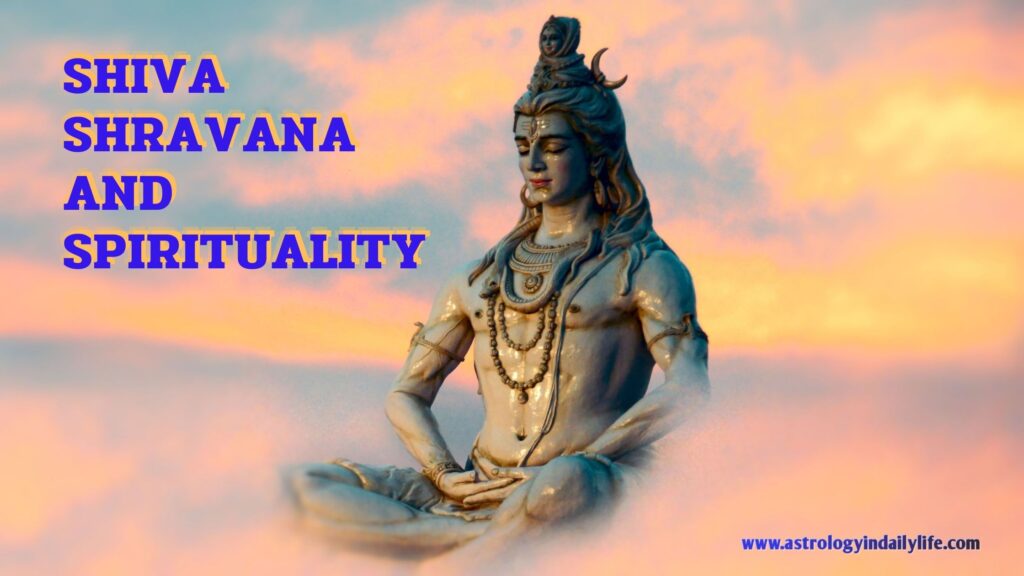
Shravana Maas - 2024
In 2024, the Purnimanta Shravan month will begin on Monday, July 22, and end on Monday, August 19, lasting 29 days. This period is noteworthy as it begins and ends on a Monday, doubling its significance. For the Southern and Western states of India, including Maharashtra, Shravan will start on August 5, 2024, and conclude on September 3, 2024.
This year is special because it includes five Mondays in the month, a unique occurrence: July 22, July 29, August 5, August 12 and August 19.
Some auspicious days in the Shravan Month in 2024 are:
- July 22: First day of Shravan Month
- August 7: Hariyali Teej
- August 9: Nag Panchami
- August 12: Shravan Shivratri
- August 17: Shravan Putrada Ekadashi
- August 19: Raksha Bandhan
- August 26: Janmashtami
Shravana Maas is the fourth month of the Hindu calendar. It is the fifth month of the solar year and the first of the Chaturmas (the Four Holy Months). These four months of Chaturmas are allocated traditionally for devotion, penance and meditation. The month of Shravana is very important for the entire sub-continent of India as it marks the arrival of the South-West monsoons. And, as we all know, Shravana month is almost synonymous with fasting and prayers.

Let us understand the significance of Shravana Maas and its connection with Shiva & Spirituality:
What is the astrological significance of Shravana Maas?
Shravana month derives its name from the ‘Shravana‘ Nakshatra, also known as the Alpha Aquilae constellation or the Eagle Star. In Sanskrit, ‘Shravana’ means ‘hearing.’ This month emphasizes speaking less and listening more, encouraging one to be a focused listener. Listening is essential for acquiring knowledge, and Shravana Nakshatra is aptly called the ‘Learning Star.’ It’s no coincidence that Shravana Maas begins the day after Guru Purnima! According to Vedic astrology, individuals born under the Shravana Nakshatra are destined to achieve name and fame in the world.

The cluster of three stars of the Shravana Nakshatra represents the three steps taken by Vamana Avatar to conquer the three worlds, in the process humbling the ahamkara (ego) of the great king Bali.
Shravana month begins when the Sun moves to the sign Leo. Interestingly, all four parts of Shravana nakshatra fall in the sign of Makara (Capricorn) ruled by Saturn; while its lord is the Moon.
Why do we worship Lord Shiva in Shravana Maas?
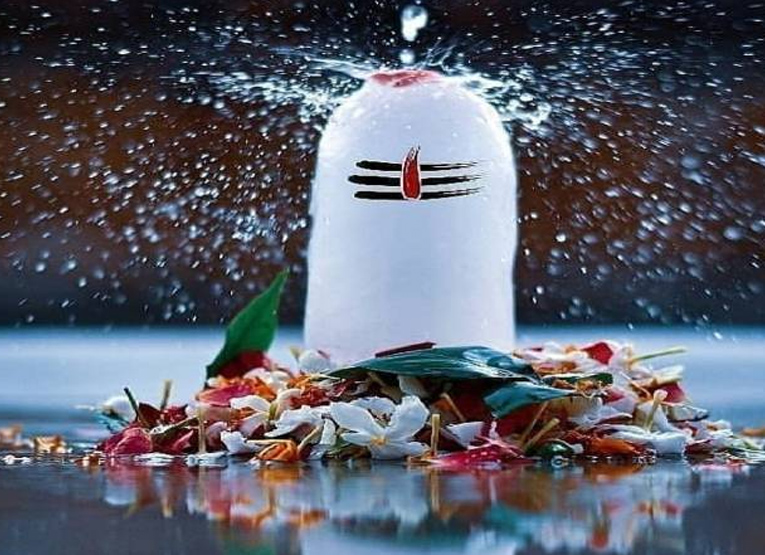
Shravana Maas, intertwined with the monsoon season, symbolizes water, which is linked to the Moon. The Moon, in turn, connects to the mind (Mann). All these elements are deeply associated with Lord Shiva, the Adi Yogi, who taught the art of controlling the mind through meditation and yoga. The name ‘Shiva‘ translates to ‘the auspicious one.’
Mythologically, the churning of the ocean (Samudra Manthan) occurred during Shravana Maas. Additionally, Rishi Markandeya perfected the Maha Mrityunjaya Mantra, dedicated to Lord Shiva, in this sacred month.
Why is Rudrabhishek so important in the month of Shravana?
It is believed that the Samudra Manthan (Churning of Nectar) took place in the month of Shravana. In the course of churning the Kshirasāgara (the ocean of milk) for Amrita (Nectar), fourteen divine gifts emerged. These included Lakshmi (the Goddess of Wealth), Kaustabha gem, Parijaat (a Divine ever-flowering tree), Kamadhenu (the Wish-fulfilling Divine Cow), Kalpavriksha (Wish-fulfilling Tree), Airavata (Indra’s Elephant), Shankha (Vishnu’s Conch), etc. Finally, the fourteenth gift was Halahal – poison.
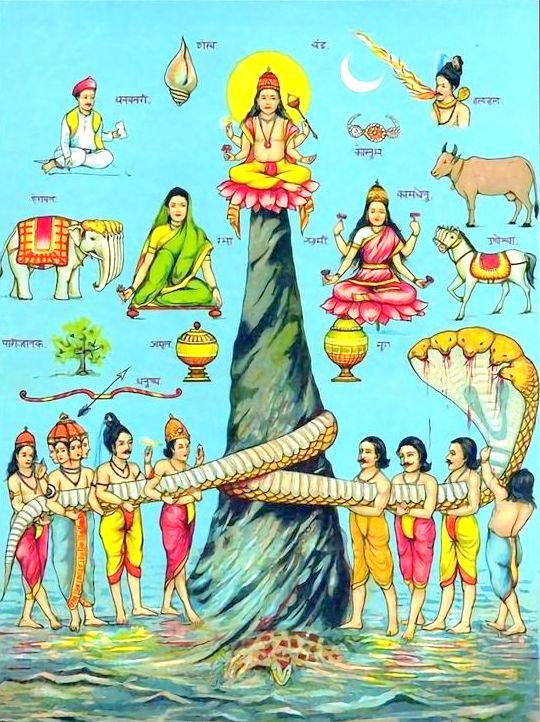
While the first 13 gifts were divided between the Asuras and the Devtas, no one was ready to take the Halahal. Shiva chose to consume the poison. He held the Halahal in His throat. This caused a burning sensation. Hence all the Devtas started offering Ganga water to Shiv to soothe the fiery impact of the poison. Thus, this continued as a symbolic tradition in the form of pouring water or milk on the Shivling. This is also known as Jal Abhishek or Rudrabhishek.
Why is the Shravana Maas considered so auspicious?
As already stated above, Shravana month marks the beginning of the auspicious period of Chaturmas. Each day of Shravana Maas is very significant. Many festivals and important days such as Shravana Somvar Vrats, Mangala Gauri Vrat, Vara Lakshmi Vrat, Shravana Putrada Ekadashi, Gayatri Jayanti, Hariyali Teej, Shravani Poornima, Narali Poornima, Raksha Bandhan, Onam, Naga Panchami, Janmashtami, etc. make this month of Shravana so very auspicious.
Just as all Mondays of Shravana month are Shravana Somvars, so also are all the Tuesdays of this month called Mangala Gauri Vrats – the married ladies fast and pray for the long life of their husbands while the unmarried ones pray for a boon of a good and worthy husband.
DIFFERENT TYPES OF FASTINGS:
During the Shravan Month, devotees observe various types of fasting, each offering unique spiritual benefits:
-
Nirjala Fasting: The most rigorous, involving complete abstinence from food and water for the entire day, believed to bring immense spiritual benefits.
-
Phalahar Fasting: Devotees consume only fruits and dairy products, making it a lighter alternative to Nirjala fasting.
-
Saatvik Fasting: Involves eating only pure, natural, fresh, and minimally processed food free from strong spices aiming to purify the mind and body.
-
Ekadashi Fasting: Observed on the 11th day of each fortnight, devotees abstain from grains and lentils, consuming only fruits, milk, milk products, nuts, seeds, etc.
-
Pradosh Vrat: Observed on the 13th day of each fortnight, devotees fast from sunrise to sunset, performing special prayers to Lord Shiva in the evening.
Why do Kaavadis carry Ganga water in the month of Shravana?
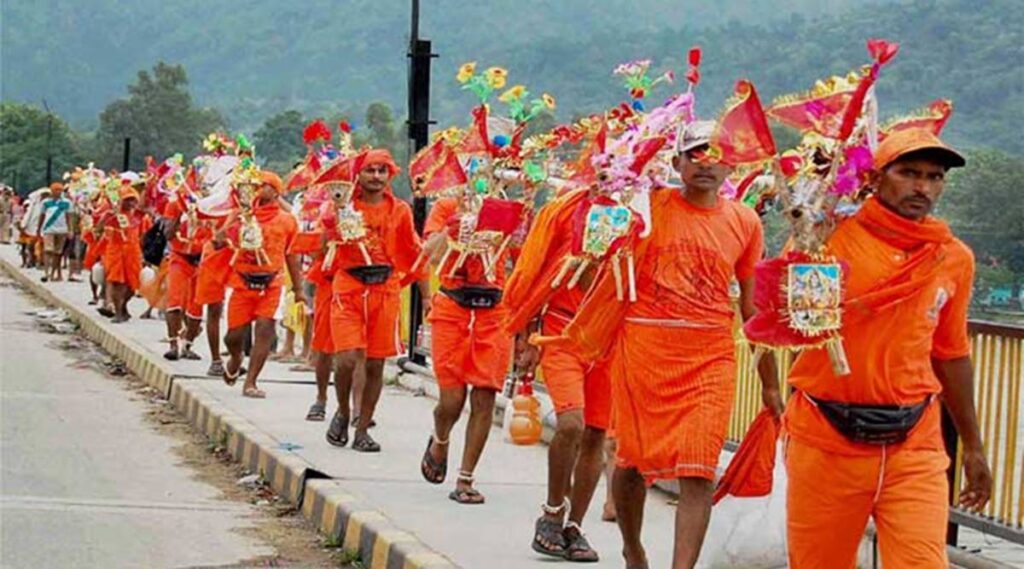
A special sect of Shiv devotees known as Kaavadis undertake a sort of pilgrimage known as Kaanvad Yatra – carrying the holy Ganga water in urns or large pots from the river Ganga to the nearby Shiv Temples. Besides, thousands of saffron-clad Kaavadis carry water from the Ganga in Haridwar, Gangotri or Gaumukh, the glacier from where the Ganga originates and other holy places, like Sultanganj in Bihar, and carry it to their hometowns, where they perform Abhishek (pouring of water) of the Shiva lings at the local Shiva temples, as a symbol of gratitude and devotion. This tradition originated in the Treta Yuga (the Silver Age of Hindu Mythology) when Lord Rama carried the holy water of river Ganga in a Kaanvad (urn) to offer it to Lord Shiva at Baba Baidyanath Dham which today is in the Deoghar district of Jharkhand.
Why are there two different dates marking the beginning of Shravana in India?
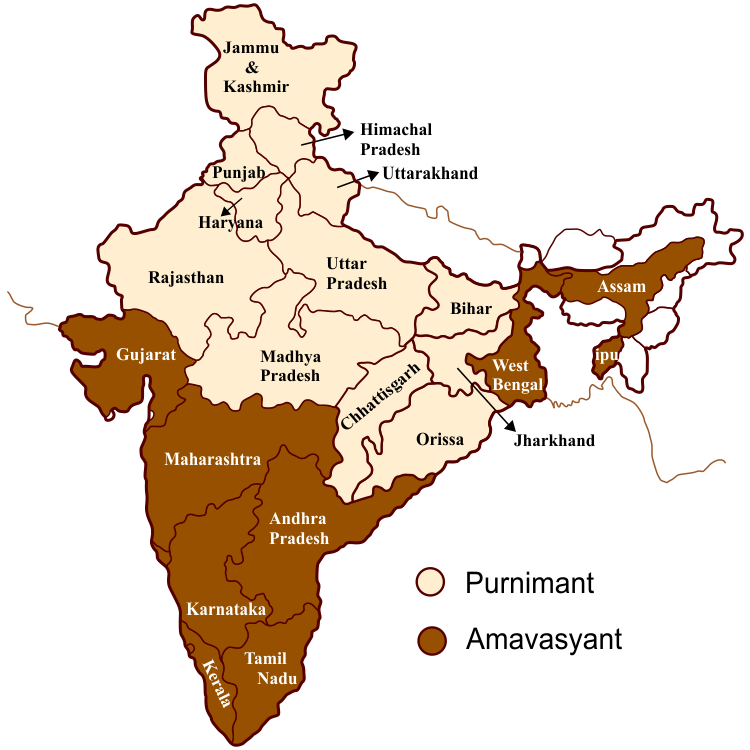
A month in the Indian calendar consists of two fortnights – from Poornima (Full Moon) to Amavasya (New Moon) and back. Now, the North Indians follow the Purnimant Calendar; that is their month begins with Poornima or the Full Moon as their calendar always begins with the Shukla Paksha. On the other hand, people in Maharashtra and South India follow the Amavasyant calendar. Their month begins from Amavasya or the New Moon since their calendar begins with Krishna Paksha. Hence there is a difference of a fortnight between the dates of the beginning of the Shravana Month in North and South of India.
Which articles can one use for performing Abhishek of Lord Shiv or Rudrabhishek?
One can use any of the following 11 items to perform the ritual of Abhishek of Lord Shiv or Rudrabhishek: milk, curd, ghee, honey, sugar/jaggery, Bael leaves/grass, coconut water, Barley water or Ganga Jal.

One can perform Jal Abhishek offering articles according to one’s zodiac sign viz Rashi:
- Aries: Mix jaggery in water and offer it to Lord Shiva every day.
- Taurus: Offer curds to Lord Shiva. This solves your wealth-related problems.
- Gemini: Offer sugarcane juice to the Deity.
- Cancer: Perform Jal Abhishek with sugar mixed in milk. Also, offer flowers with it.
- Leo: Offer red sandalwood to the Deity.
- Virgo: You can offer Bhang to the Deity.
- Libra: Offer cow’s ghee or any perfume or fragrant oil.
- Scorpio: Offer honey mixed in water to Lord Shiva.
- Sagittarius: Offer saffron mixed with milk to Lord Shiva.
- Capricorn: Offer til (sesame) oil to the Deity.
- Aquarius: Offer coconut water or mustard oil to Lord Shiva.
- Pieces: Mix saffron in water and offer it to Lord Shiva.
MANTRAS FOR RECITATION DURING SHRAVANA:
Complete Maha Mrityunjaya Mantra:
|| 𝐀𝐮𝐦 𝐇𝐚𝐮𝐦 𝐉𝐮𝐦 𝐒𝐚𝐡 𝐀𝐮𝐦 𝐁𝐡𝐮𝐫 𝐁𝐡𝐮𝐯𝐚𝐡𝐚 𝐒𝐰𝐚𝐡𝐚
𝐀𝐮𝐦 𝐓𝐫𝐚𝐲𝐚𝐦𝐛𝐚𝐤𝐚𝐦 𝐘𝐚𝐣𝐚𝐦𝐚𝐡𝐞 𝐒𝐮𝐠𝐚𝐧𝐝𝐡𝐢𝐦 𝐏𝐮𝐬𝐡𝐭𝐢𝐯𝐚𝐫𝐝𝐡𝐚𝐧𝐚𝐦
𝐔𝐫𝐯𝐚𝐫𝐮𝐤𝐦𝐢𝐯𝐚 𝐁𝐚𝐧𝐝𝐡𝐧𝐚𝐚𝐧 𝐌𝐫𝐢𝐭𝐲𝐨𝐫 𝐌𝐮𝐤𝐬𝐡𝐢𝐲𝐚 𝐌𝐚𝐚𝐦𝐫𝐢𝐭𝐚𝐚𝐭
𝐀𝐮𝐦 𝐒𝐰𝐚𝐡𝐚 𝐁𝐡𝐮𝐯𝐚𝐡 𝐁𝐡𝐮𝐡 𝐀𝐮𝐦 𝐒𝐚𝐡 𝐉𝐮𝐦 𝐇𝐚𝐮𝐦 𝐀𝐮𝐦 |
|| ॐ हौं जूं सः ॐ भूर्भुवः स्वः ॐ त्र्यम्बकं यजामहे सुगन्धिं पुष्टिवर्धनम्
उर्वारुकमिव बन्धनान् मृत्योर्मुक्षीय मामृतात् ॐ स्वः भुवः भूः ॐ सः जूं हौं ॐ ||
This mantra blesses one with long life, wealth, prosperity and mental peace. Besides, it also helps treat all physical ailments, shields against accidental death, unexpected untoward events, etc.
Mantra while doing Jal Abhishek of Lord Shiva –
𝐉𝐚𝐥 𝐃𝐡𝐚𝐚𝐫𝐞-𝐒𝐡𝐢𝐯𝐚𝐦 𝐀𝐫𝐜𝐡𝐞𝐭 𝐊𝐚𝐢𝐥𝐚𝐚𝐬𝐡 𝐕𝐚𝐬𝐚𝐭𝐞-𝐃𝐡𝐮𝐯𝐚𝐦 |
𝐌𝐮𝐜𝐡𝐲𝐚𝐭𝐞-𝐒𝐚𝐫𝐯𝐚 𝐁𝐚𝐚𝐧𝐝𝐡𝐚𝐦𝐲𝐨-𝐍𝐚𝐚𝐭𝐫𝐚 𝐊𝐚𝐫𝐲𝐚 𝐕𝐢𝐜𝐡𝐚𝐫𝐧𝐚𝐚 ||
Mantra for those desirous of getting married:
|| 𝐇𝐞𝐲 𝐆𝐚𝐮𝐫𝐢 𝐒𝐡𝐚𝐧𝐤𝐫𝐚 𝐀𝐫𝐝𝐡𝐚𝐧𝐠𝐢𝐧𝐢 𝐘𝐚𝐭𝐡𝐚 𝐓𝐚𝐰𝐚𝐦 𝐒𝐡𝐚𝐧𝐤𝐞𝐫 𝐏𝐫𝐢𝐲𝐚
𝐓𝐚𝐭𝐡𝐚 𝐌𝐚 𝐊𝐮𝐫𝐮 𝐊𝐚𝐥𝐲𝐚𝐧𝐢 𝐊𝐚𝐧𝐭𝐚 𝐊𝐚𝐧𝐭𝐚𝐦 𝐒𝐮𝐝𝐮𝐫 𝐋𝐚𝐛𝐡𝐚𝐦 ||
Click HERE to read: BEST REMEDIES FOR DELAY IN MARRIAGE
OM NAMAH SHIVAY – FULL:
𝐎𝐦 𝐍𝐚𝐦𝐚𝐡 𝐒𝐡𝐢𝐯𝐚𝐲, 𝐎𝐦 𝐍𝐚𝐦𝐚𝐡 𝐒𝐡𝐢𝐯𝐚𝐲 | 𝐇𝐚𝐫 𝐇𝐚𝐫 𝐁𝐡𝐨𝐥𝐞 𝐍𝐚𝐦𝐚𝐡 𝐒𝐡𝐢𝐯𝐚𝐲 ||
𝐉𝐚𝐭𝐚𝐚𝐝𝐡𝐚𝐫𝐚𝐚𝐲 𝐒𝐡𝐢𝐯𝐚 𝐉𝐚𝐭𝐚𝐚𝐝𝐡𝐚𝐫𝐚𝐚𝐲 | 𝐇𝐚𝐫 𝐇𝐚𝐫 𝐁𝐡𝐨𝐥𝐞 𝐍𝐚𝐦𝐚𝐡 𝐒𝐡𝐢𝐯𝐚𝐲 ||
𝐂𝐡𝐚𝐧𝐝𝐫𝐚𝐝𝐡𝐚𝐫𝐚𝐚𝐲 𝐒𝐡𝐢𝐯𝐚 𝐂𝐡𝐚𝐧𝐝𝐫𝐚𝐝𝐡𝐚𝐫𝐚𝐲 | 𝐇𝐚𝐫 𝐇𝐚𝐫 𝐁𝐡𝐨𝐥𝐞 𝐍𝐚𝐦𝐚𝐡 𝐒𝐡𝐢𝐯𝐚𝐲 ||
𝐍𝐚𝐠𝐞𝐧𝐝𝐫𝐚𝐚𝐲 𝐒𝐡𝐢𝐯𝐚 𝐍𝐚𝐠𝐞𝐧𝐝𝐫𝐚𝐚𝐲 | 𝐇𝐚𝐫 𝐇𝐚𝐫 𝐁𝐡𝐨𝐥𝐞 𝐍𝐚𝐦𝐚𝐡 𝐒𝐡𝐢𝐯𝐚𝐲 ||
𝐒𝐨𝐦𝐞𝐬𝐡𝐰𝐚𝐫𝐚𝐚𝐲 𝐒𝐡𝐢𝐯𝐚 𝐒𝐨𝐦𝐞𝐬𝐡𝐰𝐚𝐫𝐚𝐚𝐲 | 𝐇𝐚𝐫 𝐇𝐚𝐫 𝐁𝐡𝐨𝐥𝐞 𝐍𝐚𝐦𝐚𝐡 𝐒𝐡𝐢𝐯𝐚𝐲 ||
𝐆𝐚𝐧𝐠𝐚𝐝𝐡𝐚𝐫𝐚𝐚𝐲 𝐒𝐡𝐢𝐯𝐚 𝐆𝐚𝐧𝐠𝐚𝐝𝐡𝐚𝐫𝐚𝐚𝐲 | 𝐇𝐚𝐫 𝐇𝐚𝐫 𝐁𝐡𝐨𝐥𝐞 𝐍𝐚𝐦𝐚𝐡 𝐒𝐡𝐢𝐯𝐚𝐲 ||
𝐍𝐚𝐧𝐝𝐢𝐬𝐡𝐰𝐚𝐫𝐚𝐚𝐲 𝐒𝐡𝐢𝐯𝐚 𝐍𝐚𝐧𝐝𝐢𝐬𝐡𝐰𝐚𝐫𝐚𝐚𝐲 | 𝐇𝐚𝐫 𝐇𝐚𝐫 𝐁𝐡𝐨𝐥𝐞 𝐍𝐚𝐦𝐚𝐡 𝐒𝐡𝐢𝐯𝐚𝐲 ||
𝐎𝐦 𝐍𝐚𝐦𝐚𝐡 𝐒𝐡𝐢𝐯𝐚𝐲, 𝐎𝐦 𝐍𝐚𝐦𝐚𝐡 𝐒𝐡𝐢𝐯𝐚𝐲 | 𝐇𝐚𝐫 𝐇𝐚𝐫 𝐁𝐡𝐨𝐥𝐞 𝐍𝐚𝐦𝐚𝐡 𝐒𝐡𝐢𝐯𝐚𝐲 ||
ॐ नमः शिवाय| ॐ नमः शिवाय | हर हर भोले नमः शिवाय ||
जटाधराय शिव जटाधराय | हर हर भोले नमः शिवाय ||
चंद्राधराय शिव चंद्राधराय | हर हर भोले नमः शिवाय ||
नागेन्द्राय शिव नागेन्द्राय | हर हर भोले नमः शिवाय ||
सोमेश्वराय शिव सोमेश्वराय | हर हर भोले नमः शिवाय ||
गंगाधराय शिव गंगाधराय | हर हर भोले नमः शिवाय ||
नन्दीश्वराय शिव नन्दीश्वराय | हर हर भोले नमः शिवाय ||
ॐ नमः शिवाय| ॐ नमः शिवाय | हर हर भोले नमः शिवाय ||



Blessed to know such insights. Keep sharing keep posting and keep motivating us.
Thank you so much for this in-depth information